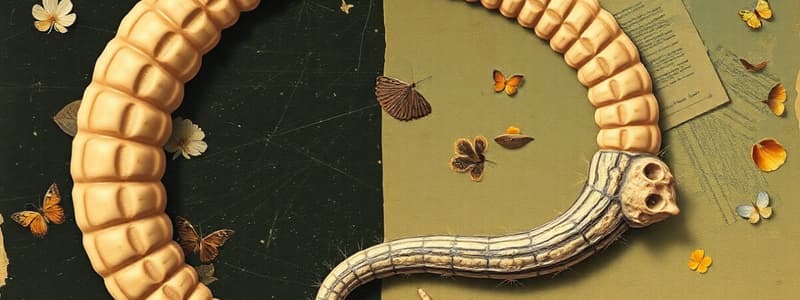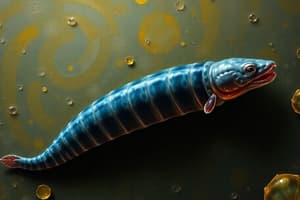Podcast
Questions and Answers
What type of movement is permitted by the contraction of lateral myofibrils in organisms with a nerve net?
What type of movement is permitted by the contraction of lateral myofibrils in organisms with a nerve net?
- Circular movement
- Rotational movement
- Translational movement
- Peristaltic-type movement (correct)
Which of the following classes does NOT belong to the Phylum Platyhelminthes?
Which of the following classes does NOT belong to the Phylum Platyhelminthes?
- Monogenea
- Nematoda (correct)
- Turbellaria
- Cestoda
What type of symmetry is exhibited by organisms within Phylum Platyhelminthes?
What type of symmetry is exhibited by organisms within Phylum Platyhelminthes?
- Asymmetry
- Radial symmetry
- Bilateral symmetry (correct)
- Spherical symmetry
What characteristic defines Platyhelminthes as triploblastic acoelomates?
What characteristic defines Platyhelminthes as triploblastic acoelomates?
What feature distinguishes the lifestyle of organisms in the Turbellaria class within Phylum Platyhelminthes?
What feature distinguishes the lifestyle of organisms in the Turbellaria class within Phylum Platyhelminthes?
What does osmoregulation in flatworms primarily involve?
What does osmoregulation in flatworms primarily involve?
Which class within Phylum Platyhelminthes typically uses an external parasitic mode?
Which class within Phylum Platyhelminthes typically uses an external parasitic mode?
In a nerve net system, which function is primarily associated with the contraction of longitudinal myofibrils?
In a nerve net system, which function is primarily associated with the contraction of longitudinal myofibrils?
Which characteristic is true for all members of the Platyhelminthes phylum?
Which characteristic is true for all members of the Platyhelminthes phylum?
What is the primary function of rhabdites in the Planarian's epidermis?
What is the primary function of rhabdites in the Planarian's epidermis?
Which structure is responsible for the attachment and release of the epidermis to the substrate during locomotion?
Which structure is responsible for the attachment and release of the epidermis to the substrate during locomotion?
Which muscle type contributes to the subtle muscular contraction for locomotion in Planarians?
Which muscle type contributes to the subtle muscular contraction for locomotion in Planarians?
What type of epidermis is found on the ventral side of the Planarian?
What type of epidermis is found on the ventral side of the Planarian?
What is the role of the paired viscid cells in the dual-gland adhesive organs?
What is the role of the paired viscid cells in the dual-gland adhesive organs?
Which feature assists in the Planarian's locomotion aside from ciliated movement?
Which feature assists in the Planarian's locomotion aside from ciliated movement?
What primarily composes the parenchymal muscle in Planarians?
What primarily composes the parenchymal muscle in Planarians?
What is one function of the cilia on the ventral epidermis of Planarians?
What is one function of the cilia on the ventral epidermis of Planarians?
What characteristic distinguishes the dorsal epidermis from the ventral epidermis in Planarians?
What characteristic distinguishes the dorsal epidermis from the ventral epidermis in Planarians?
How do anchor cells function in Planarian locomotion?
How do anchor cells function in Planarian locomotion?
What is the simplest nervous system described in the content?
What is the simplest nervous system described in the content?
Which structure is part of the nerve organization that resembles a ladder?
Which structure is part of the nerve organization that resembles a ladder?
What type of nerve integrative structure is mentioned alongside the nerve cords?
What type of nerve integrative structure is mentioned alongside the nerve cords?
How many pairs of nerve cords are suggested to be present in the described system?
How many pairs of nerve cords are suggested to be present in the described system?
What type of sensory receptor is NOT mentioned in the content?
What type of sensory receptor is NOT mentioned in the content?
What organ is suggested to be located near the auricle in the nervous system structure?
What organ is suggested to be located near the auricle in the nervous system structure?
Which type of nerve coordination is indicated as part of the nervous system's complexity?
Which type of nerve coordination is indicated as part of the nervous system's complexity?
How is the subepidermal nerve plexus primarily characterized?
How is the subepidermal nerve plexus primarily characterized?
Which of the following terms is used to describe the response of the nervous system to touch?
Which of the following terms is used to describe the response of the nervous system to touch?
Which of the following is NOT a sensory receptor mentioned in the nervous system structure?
Which of the following is NOT a sensory receptor mentioned in the nervous system structure?
What is the primary function of the flame cell in the protonephridium?
What is the primary function of the flame cell in the protonephridium?
How does the flagellar beat of the flame cell affect fluid movement?
How does the flagellar beat of the flame cell affect fluid movement?
What structure is formed by the interdigitation of cells surrounding the flame cell?
What structure is formed by the interdigitation of cells surrounding the flame cell?
What is the term used to describe the ultrafiltered fluid modified within the tubule system?
What is the term used to describe the ultrafiltered fluid modified within the tubule system?
What type of cell is the flame cell described as?
What type of cell is the flame cell described as?
Where is the flame cell located in relation to the tubule?
Where is the flame cell located in relation to the tubule?
What is the term for the pores through which modified fluid is eliminated from the body?
What is the term for the pores through which modified fluid is eliminated from the body?
Which of the following is NOT a component of the tubule system associated with flame cells?
Which of the following is NOT a component of the tubule system associated with flame cells?
What is the significance of cellular interdigitation in the protonephridium?
What is the significance of cellular interdigitation in the protonephridium?
Flashcards are hidden until you start studying
Study Notes
Phylum Platyhelminthes: Introduction
- Flatworms, flukes, and tapeworms.
- Bilateral symmetry, triploblastic acoelomates.
- Tissue-organ level of organization.
- Includes classes Turbellaria (free-living), Trematoda (parasitic), Monogenea (parasitic), and Cestoda (parasitic).
Body Form and Structure
- Cross-section of Planarian (Turbellaria): Dorsal (non-ciliated epidermis), ventral (ciliated epidermis), pharynx, intestine, nerve cords, dual-gland adhesive organs, and rhabdite cells.
- Ciliated Ventral Epidermis: Facilitates locomotion.
- Musculature: Parenchymal, longitudinal, and circular muscles.
- Specialized Epidermal Structures:
- Rhabdites: Rod-shaped vesicles from Golgi bodies; released into the environment, forming a mucous coat for protection.
- Dual-gland adhesive organs: Mediate attachment and release from substrate; composed of viscid cells (producing adhesive), anchor cells, and releasing cells.
Locomotion
- Achieved through ciliated ventral surface, subtle muscular contractions, and dual-gland adhesive organs.
- Dual-gland adhesive organs use viscid cells for attachment, anchor cells to bear the strain, and releasing cells for detachment.
Osmoregulation
- Protonephridia: An 'inverted' flagellated flame cell within a mesh cup (tubule end).
- Flagellar beat creates negative pressure, drawing fluid through the mesh (ultrafiltration).
- Modified fluid is eliminated through excretory pores (nephridopores).
Nervous Tissue
-
Three types of organization:
- Subepidermal nerve plexus: Simplest, resembling a diffuse nerve net.
- Subepidermal nerve plexus + longitudinal nerve cords: One to five pairs of nerve cords under the musculature.
- Nerve cords + primitive brain: One to three pairs of nerve cords with connecting nerves (ring commissures) forming a "ladder-type" pattern; includes cerebral ganglion.
-
Sensory Structures (Auricles): Tactile receptors, chemoreceptors, rheoreceptors, statocysts (gravity), and photoreceptors (ocelli).
Neuromuscular System
- Lateral nerve net: Contraction of lateral myofibrils allows peristaltic movement.
- Longitudinal nerve net: Contraction of longitudinal myofibrils permits body and/or tentacle shortening.
Studying That Suits You
Use AI to generate personalized quizzes and flashcards to suit your learning preferences.




